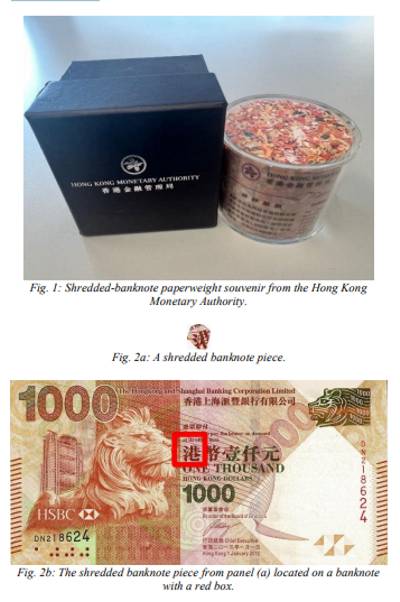| Reconstructing Banknotes Using Computer Vision |
| Written by Sue Gee |
| Sunday, 21 January 2024 |
|
Until recently visitors to the Hong Kong Monetary Authority visitor center, visitors could take home a paperweight souvenir costing $100 HKD, and was claimed to contain shredded banknotes equivalent to 138 complete banknotes of $1000 HKD. Could computer vision reconstruct notes from masses of tiny shreds? What should happen to old banknotes? This is a problem faced by all governments and banking authorities. Incinerating money is one viable means of disposal and composting it to use as a soil improver is another. But the US and Hong Kong had the idea of selling shredded banknotes as a novelty souvenir - and a visit to the Hong Kong Monetary Authority led Chung To Kong, a PhD candidate at HKU, to speculate on the possibility that, using computer vision, an entire banknote could be reconstructed like a jigsaw puzzle. He has subsequently written an arXiv paper with the title "The possibility of making $138,000 from shredded banknote pieces using computer vision". While this suggests the idea of making a fraudulent profit, rather it is intended as a proof of concept so that the banking industry can be aware of this loophole in creating money. The exercise focused on the viability of converting shredded banknotes to complete banknotes, bearing in mind that for a bank to replace a damaged or partially destroyed note the requirement is for "at least half of the banknote and visible serial number.”
For over a decade, computer vision has proved very useful in reconstructing documents. 2011 was the year of the DARPA Shredder Challenge composed of five separate problems in which the number of documents, subject matter and the method of shredding is varied to present challenges of increasing difficulty. The approach adopted by the winning team "All Your Shreds Are Belong to U.S." combined custom-coded computer vision algorithms for suggesting fragment pairings with human verification and assembly. It demonstrated the effectiveness of human-machine collaboration and since then improvements in computer vision and machine learning has reduced the need for the human contribution. Computer vision has also been applied to solving jigsaw puzzles. In the case of the Hong Kong banknotes, the irregular shapes and the tiny size of the pieces made it akin to a challenging jigsaw puzzle. Banknotes have unique serial numbers and these are shown in two specific locations. Machine learning was used to look for shreds containing parts of serial numbers. Training only required 100 images of two classes - with and without a serial number for training. Mapping the face and reverse of banknotes from three different banks required more training but the conclusion reached was: Use of computer vision has demonstrated a high possibility of reconstructing banknotes from shredded banknote pieces. Ironically the study disproved the possibility of making $138,000 from a souvenir costing $100 by finding that the paperweights contained far fewer banknotes than the 138 notes claimed. Instead the weight was made up with small stones and the outcome of the study, as reported in its final sentence is that: The paperweight souvenir is currently no longer available. Looking for an equivalent in the United States? The online Washington DC Gift Shop offers Shredded Money $150 Dollars. Each three-in-one package costs $20 and its green and grey evenly cut shreds presumably offer the same doubtful scope for fraudulent reconstruction - but with only $50 per container at most, it really doesn't seem worth the effort. More InformationThe possibility of making $138,000 from shredded banknote pieces using computer vision Related ArticlesSolving Archaeological Jigsaw Puzzles To be informed about new articles on I Programmer, sign up for our weekly newsletter, subscribe to the RSS feed and follow us on Twitter, Facebook or Linkedin.
Comments
or email your comment to: comments@i-programmer.info |
| Last Updated ( Sunday, 21 January 2024 ) |



